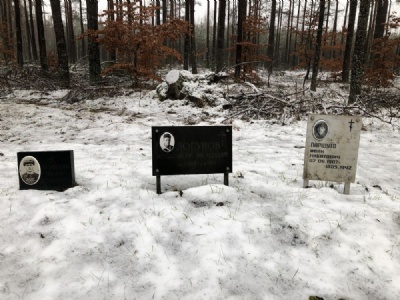Czarne – Stalag II B
About 150 kilometres northwest of Bydgoszcz lies Czarne (german Hammerstein) and there Germanny established a prisoner of war camp called Stalag II B in 1939. It was set up in a former military training area which during First World War had been a camp for Russian prisoners of war. By 1933, the Nazis set up a camp for political opponents. The first prisoners of war were Polish soldiers captured in connection with the German invasion of Poland in September 1939. Later during the war, belgian, french, serbian, american, italian and soviet prisoners of war were sent to the camp. The prisoners were forced to live in inadequate barracks with more or less non-existent sanitary facilities. Allt this led to the spread of diseases which caused many deaths. Hunger and cold also contributed to a high mortality among the prisoners. The prisoners were also forced to perform slave labor, although this was not allowed according to Geneva Convention.
In June 1941, a new camp was established just south of the first. Its main purpose was to house Soviet prisoners of war who were taken prisoners in connection with the invasion of the Soviet union same month. The new camp was called Lager-Ost, while the old camp was named Lager-Nord, or Stalag 315. Italian and Serbian POW were also sent to Lager-Ost. In Lager-Ost, a typhoid epidemic that lasted until March 1942 erupted in November 1941, causing between 40,000 – 50,000 deaths. There was a resistance movement in the camp and escape attempts were made, some succeeded, others did not. Both camps had an nearby cemetery where prisoners who died were buried in mass graves. At the end of January 1945, the Germans began to evacuate the prisoners westward as a result of the approaching front. The camp was liberated by the Soviet Red army in April 1945. An estimated 65,000 prisoners of war died in the camp.
Current status: Demolished with monument (2024).
Location: 53°41' 43.44" N 16°53' 59.22" E
Get there: Car.
Follow up in books: Bob, Fedorowich, Kent: Prisoners of War and Their Captors in World War II (1996).







There are monuments and cemeteries at both camp sites. The monument at Lager-Ost was inaugurated as late as 2021. The monument at Lager-Nord appears to have been established sometime during the Communist period. Of the camps themselves, there are remains left in former camp areas. When I was there in February 2024 it was rain and snow so it was not possible to find any remnants of the camp. The cemetery belonging to Lager-Nord seems to be within some kind of semi-military area so it was not possible to visit.